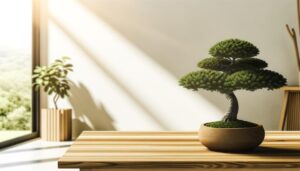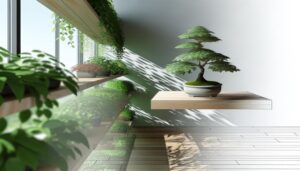Creating Harmony with Bonsai Trees and Betta Fish Tanks
Integrating a bonsai tree with a betta fish creates a synergistic aquatic micro-ecosystem with both ecological and visual benefits. Selecting aquatic-adapted bonsai species like Ficus retusa ensures thriving growth in nutrient-rich water.
Maintaining best water quality is essential, with pH ranging from 6.5-7.5 and temperatures between 76-82°F. Betta fish, known for their adaptability and vibrant colors, prefer solitary environments and stable parameters.
Cultivation includes periodic root pruning, appropriate soil substrates, and balanced lighting. Regular water changes and filtration are essential.
This harmonious cohabitation can greatly enhance biological diversity and aesthetic appeal. Discover more detailed insights on setup and care.

Key Takeaways
- Select aquatic-adapted bonsai species like Ficus retusa and Willow Leaf Fig.
- Maintain water quality with a pH of 6.5-7.5 and a temperature of 76-82°F.
- Ensure a minimum tank size of 5 gallons for the Betta fish.
- Regularly prune bonsai roots and monitor water parameters to sustain balance.
- Betta fish benefit from nutrient cycling, with bonsai aiding in water filtration.
Choosing the Right Bonsai

When selecting a bonsai tree to accompany a betta fish, it is important to think about species that thrive in aquatic environments and possess root structures that do not adversely affect water quality.
Aquatic-adapted species such as the Ficus retusa and the Willow Leaf Fig (Ficus nerifolia) are ideal, as they can tolerate submersion and have non-invasive roots.
Detailed observations reveal that these species exhibit best growth in nutrient-rich water, maintaining a balanced pH level, thereby fostering a stable ecosystem for both plant and fish.
Cultivation techniques involve pruning roots periodically to prevent excessive nutrient uptake and using appropriate aquatic soil substrates.
Ensuring adequate light and monitoring water parameters are critical to the symbiotic relationship between the bonsai and the betta fish.
Selecting a Betta Fish
Selecting a betta fish that complements the chosen bonsai species requires evaluating the fish's temperament, water parameter tolerance, and compatibility with the aquatic environment fostered by the bonsai. Betta splendens, known for their iridescent colors and flowing fins, are ideal due to their adaptability. However, their territorial nature requires careful selection to avoid stress and aggression.
| Trait | Ideal Condition | Observation |
|---|---|---|
| Temperament | Non-confrontational | Calm, avoids territorial fights |
| Water Temperature | 76-82°F (24-28°C) | Thrives in warm environments |
| pH Level | 6.5-7.5 | Neutral to slightly acidic |
| Tank Size | Minimum 5 gallons | Spacious for active swimming |
| Compatibility | Solitary | Prefers being alone |
Understanding these factors guarantees a harmonious integration of betta fish with the bonsai ecosystem.
Setting Up the Environment

Creating an ideal environment for both the bonsai tree and betta fish necessitates meticulous attention to water quality, lighting conditions, and substrate composition.
Best water quality is achieved by maintaining a pH range of 6.5-7.5 and a temperature between 76-82°F.
Lighting should simulate natural daylight, approximately 8-12 hours per day, to support photosynthesis for the bonsai and circadian rhythms for the betta.
Utilize a substrate blend of fine gravel and aquatic soil to foster root development while ensuring adequate nutrient absorption.
Regular water filtration and partial water changes are imperative to prevent toxic ammonia buildup and to maintain clarity.
Each component must be harmonized to create a balanced micro-ecosystem conducive to the health of both organisms.
Maintenance and Care Tips
Proper maintenance and care are crucial to sustaining the symbiotic balance between the bonsai tree and betta fish, ensuring their continued health and well-being.
Regular water quality assessment is crucial; parameters such as pH (6.5-7.5), ammonia, nitrite, and nitrate levels must be meticulously monitored and adjusted. Weekly water changes of 20-30% are recommended to prevent toxin accumulation.
Pruning the bonsai to control its size and shape is essential, using sterilized tools to avoid disease transmission. Nutrient supplementation via fertilization should be carefully dosed to prevent water contamination.
Additionally, maintaining a stable temperature (76-80°F) and ensuring adequate light exposure (8-10 hours daily) are necessary for both the aquatic and botanical components to thrive harmoniously.
Benefits of the Combination

The harmonious integration of a bonsai tree with a betta fish in a shared ecosystem offers numerous ecological and aesthetically pleasing advantages that enhance both the visual appeal and biological diversity of the environment.
The mutual relationship between the aquatic and terrestrial elements facilitates nutrient cycling, where fish waste acts as a natural fertilizer for the bonsai, promoting robust growth.
Detailed observations reveal that the plant, in turn, aids in water filtration, maintaining ideal water quality for the betta fish.
Cultivation techniques such as controlled lighting and regulated feeding schedules ensure the well-being of both organisms.
This harmonious coexistence not only creates a visually appealing display but also fosters a balanced micro-ecosystem, making it a sustainable and enriching choice for enthusiasts.
Conclusion
To sum up, the symbiotic pairing of a bonsai tree with a Betta fish demonstrates the intricate balance of terrestrial and aquatic ecosystems. This integration requires meticulous selection, precise environmental setup, and diligent maintenance. Such a combination not only enhances aesthetic appeal but also embodies the maxim, 'Nature abhors a vacuum,' highlighting the interdependence of life forms.
The meticulous care and observation necessary for thriving coexistence underscore the profound beauty and complexity inherent in natural systems.






